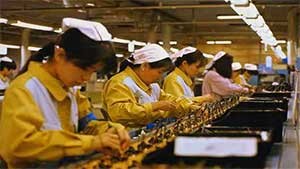More Changes In Japan
 Long sustained very high growth meant very high levels of capacity increases to build critical market share, this high growth financed as it must be by low-cost debt, borrowed from supportive banks. With fund availability greatly increased by a tripling of the value of the yen followed by a massive increase in asset values in the ’80s, companies were able to engage in extensive diversification. Too much capacity; too many competitors in almost all industries; too much diversification; all this too dependent on borrowings–the elements for a wrenching and long period of deflation and restructuring were in place. The end to the bubble of the late ’80s provided the occasion and the tow growth of the economy from 1992 is the evidence.
Long sustained very high growth meant very high levels of capacity increases to build critical market share, this high growth financed as it must be by low-cost debt, borrowed from supportive banks. With fund availability greatly increased by a tripling of the value of the yen followed by a massive increase in asset values in the ’80s, companies were able to engage in extensive diversification. Too much capacity; too many competitors in almost all industries; too much diversification; all this too dependent on borrowings–the elements for a wrenching and long period of deflation and restructuring were in place. The end to the bubble of the late ’80s provided the occasion and the tow growth of the economy from 1992 is the evidence.
Industry Reorganization and Company Restructuring
To deal with over-capacity and excessive diversification, much of industry can be seen in two groups. The first includes producers of cement, paper and pulp, chemicals, petrochemicals, refined petroleum and steel–pollution/energy/raw material intensive industries greatly dependent on scale. The steel industry exemplifies these industries’ moves, as the number of integrated steel producers, stripped of their abortive efforts in the ’80s to diversify, has moved from five to four already with the four in process of becoming two. These two will be among the world’s largest as Nippon Steel incorporates elements of Kobe Steel and Sumitomo Metals, and quite able to lead the world’s industry for some years still. The forthcoming merger of Sumitomo Chemical and Mitsui Chemical will create the fifth largest chemical company in the world, Japan’s first entry into the top rank in that industry. Much of this type of industry reorganization has already taken place, aided by repeal of the Anti-Holding Company Law, with capacity rationalization restoring world competitiveness.
An even more difficult problem than that of excess capacity is the result of extreme diversification. High growth made market entry easy, with seeming success from early sales, while low-cost funds were amply available to finance diversity. Companies in many of Japan’s industries fell into the diversification trap, but the most serious victims were the electrical equipment/ electronics companies. Toshiba, Hitachi, NEC, Fujitsu, Mitsubishi Electric and Oki Electric are attempting to restore focus to their enterprises–to concentrate their limited resources to achieve leading positions in businesses in which they have some prospect of achieving competitive success.
NEC serves well both as an example of extraordinary success and exceptional problems. The first company I had the privilege of studying in my research into Japanese industry in 1955/6, NEC was then a company with sales of some $25 million. Its sales increased over the next 45 years by 1,600 times. NEC moved from producing telecommunications equipment with licensed technology to being a world leader in “computers and communications” in Dr. Kobayashi Koji’s famous phrase. However, it went on to greatly over-diversify, moving for example from world leader in semiconductors in 1991 to a poor sixth in 2001 as it presumed to compete in essentially all types of semiconductors against such focused competitors as Intel and Samsung.
In the past three years, NEC has moved dramatically to restructure. It has redefined its business goals, halved the number of board members, used outside advisors intensively, exited a series of businesses, sold a number of its factories at home and abroad, slashed fringe benefit payments, and announced its intention to use China as a site for mass production of conventional products, while dividing the company into three corporate units and spinning off one, Electron Devices, preparing to take it public. Is all this restructuring needed? Clearly, since there is really no option but to clear away earlier excess.
While it required several years for most companies to fully appreciate the magnitude of their problems, the moves being taken now by Japan’s companies are the surest guarantee of future success. Companies like NEC and Nippon Steel continue to invest in R&D well above the levels of their world competitors with very high outputs of patents an assurance of future growth. With leading edge technology, a superb labor force, and the highest level of capital formation in the world, overcoming current stagnation is a matter of time, and limited time at that.
The general configuration is clear–heavy investment abroad for conventional manufacture using inexpensive and competent Asian labor to balance a limited labor force at home; very high levels of research and development with domestic labor and facilities producing new and high value added products; the export surplus rapidly diminishing as the current account remains positive from returns on overseas investment–a very rich, very stable world center for technology development and research.
